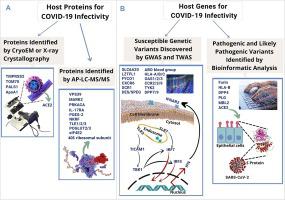Gene ( IF 2.6 ) Pub Date : 2021-09-14 , DOI: 10.1016/j.gene.2021.145963 Zohreh Jahanafrooz 1 , Zhishan Chen 2 , Jiandong Bao 3 , Hongzhi Li 4 , Loren Lipworth 2 , Xingyi Guo 5

|
As of July 2021, the outbreak of coronavirus disease 2019 (COVID-19), caused by SARS-CoV-2, has led to more than 200 million infections and more than 4.2 million deaths globally. Complications of severe COVID-19 include acute kidney injury, liver dysfunction, cardiomyopathy, and coagulation dysfunction. Thus, there is an urgent need to identify proteins and genetic factors associated with COVID-19 susceptibility and outcome. We comprehensively reviewed recent findings of host-SARS-CoV-2 interactome analyses. To identify genetic variants associated with COVID-19, we focused on the findings from genome and transcriptome wide association studies (GWAS and TWAS) and bioinformatics analysis. We described established human proteins including ACE2, TMPRSS2, 40S ribosomal subunit, ApoA1, TOM70, HLA-A, and PALS1 interacting with SARS-CoV-2 based on cryo–electron microscopy results. Furthermore, we described approximately 1000 human proteins showing evidence of interaction with SARS-CoV-2 and highlighted host cellular processes such as innate immune pathways affected by infection. We summarized the evidence on more than 20 identified candidate genes in COVID-19 severity. Predicted deleterious and disruptive genetic variants with possible effects on COVID-19 infectivity have been also summarized. These findings provide novel insights into SARS-CoV-2 biology and infection as well as potential strategies for development of novel COVID therapeutic targets and drug repurposing.
中文翻译:

与 SARS-CoV-2 感染有关的人类蛋白质和基因概述
截至 2021 年 7 月,由 SARS-CoV-2 引起的 2019 年冠状病毒病 (COVID-19) 爆发已导致全球超过 2 亿人感染,超过 420 万人死亡。严重 COVID-19 的并发症包括急性肾损伤、肝功能障碍、心肌病和凝血功能障碍。因此,迫切需要确定与 COVID-19 易感性和结果相关的蛋白质和遗传因素。我们全面回顾了宿主-SARS-CoV-2 相互作用组分析的最新发现。为了识别与 COVID-19 相关的遗传变异,我们重点关注了基因组和转录组广泛关联研究(GWAS 和 TWAS)和生物信息学分析的结果。我们描述了已建立的人类蛋白质,包括 ACE2、TMPRSS2、40S 核糖体亚基、ApoA1、TOM70、HLA-A、根据冷冻电子显微镜结果,PALS1 与 SARS-CoV-2 相互作用。此外,我们描述了大约 1000 种人类蛋白质,显示出与 SARS-CoV-2 相互作用的证据,并强调了宿主细胞过程,例如受感染影响的先天免疫途径。我们总结了 20 多个确定的 COVID-19 严重性候选基因的证据。还总结了可能对 COVID-19 传染性产生影响的预测有害和破坏性遗传变异。这些发现提供了对 SARS-CoV-2 生物学和感染的新见解,以及开发新型 COVID 治疗靶点和药物再利用的潜在策略。我们描述了大约 1000 种人类蛋白质,显示出与 SARS-CoV-2 相互作用的证据,并强调了宿主细胞过程,例如受感染影响的先天免疫途径。我们总结了 20 多个确定的 COVID-19 严重性候选基因的证据。还总结了可能对 COVID-19 传染性产生影响的预测有害和破坏性遗传变异。这些发现提供了对 SARS-CoV-2 生物学和感染的新见解,以及开发新型 COVID 治疗靶点和药物再利用的潜在策略。我们描述了大约 1000 种人类蛋白质,显示出与 SARS-CoV-2 相互作用的证据,并强调了宿主细胞过程,例如受感染影响的先天免疫途径。我们总结了 20 多个确定的 COVID-19 严重性候选基因的证据。还总结了可能对 COVID-19 传染性产生影响的预测有害和破坏性遗传变异。这些发现提供了对 SARS-CoV-2 生物学和感染的新见解,以及开发新型 COVID 治疗靶点和药物再利用的潜在策略。











































 京公网安备 11010802027423号
京公网安备 11010802027423号